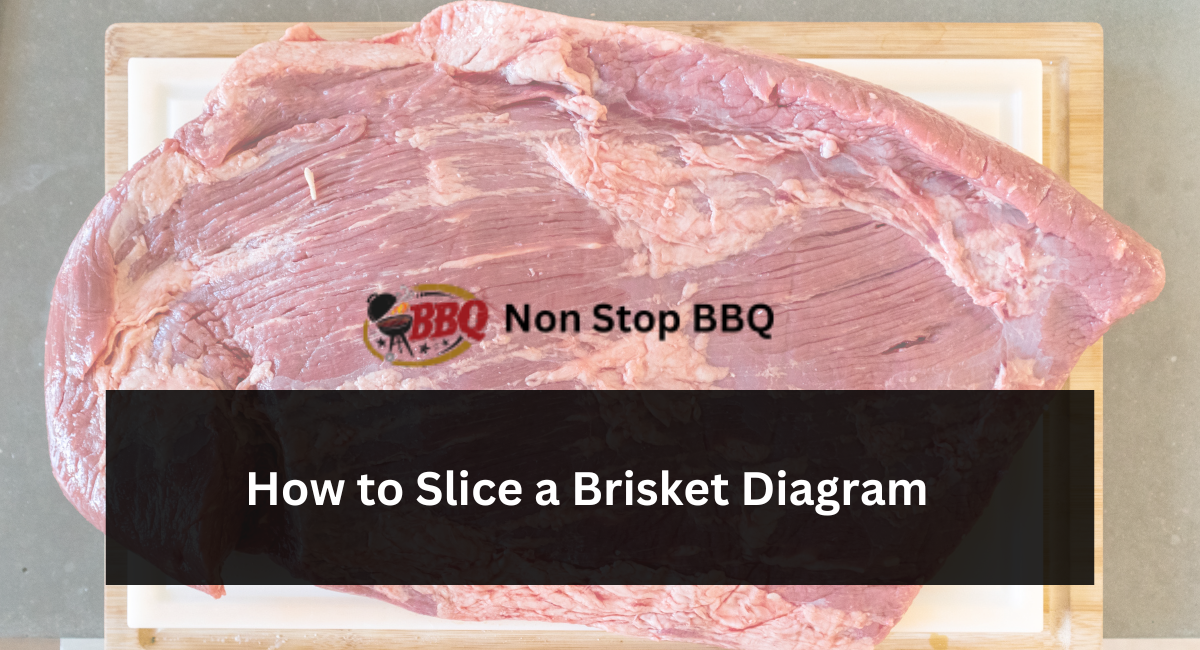Slicing brisket is a very underestimated aspect of the procedure. Although many individuals focus on the lengthy cooking time of 12+ hours, they often overlook the importance of resting and slicing the food properly.
Cutting brisket is quite simple, the aim is to slice across the fibers and generate slices that are approximately the thickness of a pencil.
However, there are further subtleties to consider, such as understanding the appropriate place to initially divide the brisket and when to perform a “Texas Turn.”
Slicing means cutting the brisket after it has been smoked and rested. Trimming means trimming the brisket before smoking it. If you want to learn how to trim your brisket, I have another article for that.
How to Cut Brisket:
Cutting brisket is really simple. The main thing to keep in mind is to cut across the fibers.
What is the direction of the grain in brisket?
To begin with, muscle fibers are elongated strands and their alignment is referred to as the “grain.”
On a functioning muscle, such as the brisket, the grain is clearly visible due to the dense muscular fiber bundles.
For any situation, it is consistently simpler to determine the grain orientation of meat while it is uncooked. Even capturing an image of the meat before to smoking it can be beneficial – it also won’t alter its course simply because it has been cooked.
Now, some people might disagree with me and suggest that you should attempt to cut as straight as possible to make the fiber lengths shorter, but as a casual BBQ enthusiast, this isn’t really essential.
Slicing brisket at an angle and perpendicular to the muscle fibers is not as important when it comes to brisket.
As someone who enjoys backyard grilling, if you slice your brisket the same manner I did below (in white), you will still achieve excellent slices that no one will have any complaints about.
According to the grain orientation shown above, here’s the method for slicing brisket:
If you aim to slice the brisket against the grain, it’s important to note that the grain of the meat changes direction. This means that you will need to adjust the angle of your knife and slices accordingly.
Unlike a steak, brisket is smoked until the collagen (connective tissues) break down and become gelatinous. After smoking the brisket for more than 12 hours and then allowing it to rest for 2 hours, the flesh is already rather tender.
Some individuals may even go to the extent of creating a mark on the edge of the meat when they trim it. By doing this, they are aware of the starting point for cutting.
This feature can also result in a square-shaped border that might scorch or even cause the meat to curl or pucker when smoked.
Where to Begin Cutting:
Once you have finished smoking and allowing your brisket to rest, the initial location to cut is where the lean muscle and the fatty muscle meet.
Thus, you end up with one component that is cut in one direction and another piece that is cut in the other direction.
If you’ve read my instruction on trimming brisket, you would be aware that this happens at the “slope” section of the fat cap.
Here is an image of the meat and fat side along with the different informal expressions.
What is the Ideal Thickness for Slicing Brisket Flat and Point?
When cutting your slices, it’s truly your choice how you decide to use them and you would cut them accordingly.
Typically, the flat is cut into thin sections that are about 1/4 inch thick.
The meat is cut slightly thicker due to its higher amount of fat within the muscle. If cut too thinly, the slices could break apart because of the fat melting.
Slicing Brisket Perpendicular to the Muscle Fibers:
From the lean, you receive your classic slices and flat end cap. The flat is the simpler of the two to slice as it feels quite natural in terms of how you’re supposed to slice.
Once again, I don’t think it’s necessary to be overly precise when slicing brisket flat, especially in terms of being “perpendicular.”
“Texas Turning” the Brisket to Slice the Point:
It’s fascinating how many barbecue words are connected to Texas, don’t you think? An effective example is encasing in aluminum foil or using the “Texas Crutch.”
Another term commonly used in Texas is the “Texas Turn.”
The term “Texas Turn” simply refers to rotating the point muscle in the opposite direction of the flat muscle in order to slice it. The cause of this is because the muscle fibers run in the opposite way.
From the fatty portion, we obtain burnt ends from both the mohawk and hump sides – which are commonly regarded as the most desirable sections of the brisket.
You also receive slices that have impressive fat marbling, and the amount of fat cap you choose to keep determines the presence of delightfully rendered soft fat.
Conclusion:
Slicing brisket is an art that requires precision and attention to detail. By understanding the grain direction, knowing where to begin cutting, and mastering the “Texas Turn,” you can create perfect slices that will impress any barbecue enthusiast.
So next time you fire up the smoker, remember these tips and slice your way to barbecue perfection!

Leave a Reply